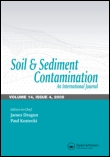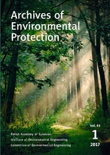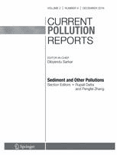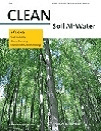
WATER AIR AND SOIL POLLUTION
Scope & Guideline
Transforming pollution management through interdisciplinary research.
Introduction
Aims and Scopes
- Water Quality Management:
Research on the assessment, monitoring, and improvement of water quality in various environments, including rivers, lakes, and groundwater, with a focus on pollutants and treatment methods. - Soil Contamination and Remediation:
Studies investigating the contamination of soils by heavy metals, organic pollutants, and other hazardous substances, alongside innovative remediation techniques such as phytoremediation and bioaugmentation. - Air Pollution and Its Health Impacts:
Exploration of air quality issues, including the sources and effects of airborne pollutants on human health and ecosystems, with a focus on innovative monitoring and mitigation strategies. - Use of Nanotechnology in Environmental Remediation:
Research on the application of nanomaterials in the treatment and removal of pollutants from water, soil, and air, highlighting their efficiency and mechanisms of action. - Microplastic Pollution:
Investigations into the sources, distribution, and environmental impacts of microplastics, along with strategies for detection, monitoring, and remediation. - Ecotoxicology and Environmental Risk Assessment:
Studies evaluating the ecological effects of pollutants on various organisms and ecosystems, providing risk assessments to inform environmental management and policy.
Trending and Emerging
- Pharmaceutical and Personal Care Products (PPCPs) in the Environment:
There is an increasing focus on the detection, effects, and removal strategies for PPCPs in water systems, reflecting growing public and regulatory concern over these contaminants. - Climate Change Impact Studies:
Research exploring the effects of climate change on water quality, soil health, and pollutant dynamics is gaining traction, highlighting the urgency of addressing climate-related environmental challenges. - Integrated Wastewater Management:
Emerging studies emphasize the integration of advanced treatment technologies and sustainable practices in wastewater management, including circular economy approaches. - Microbial Bioremediation:
Research into the use of microbial communities for the remediation of contaminated environments is expanding, showcasing innovative applications and effectiveness in tackling pollutants. - Smart Technologies in Environmental Monitoring:
The incorporation of IoT and AI technologies for real-time monitoring and management of environmental pollutants is on the rise, indicating a shift towards more data-driven approaches.
Declining or Waning
- Traditional Soil Fertility Studies:
Research focusing solely on soil fertility without considering contamination or pollution aspects seems to be decreasing, as there is a growing emphasis on the interaction between soil health and pollution. - Chemical Analysis of Pollutants:
While chemical analysis remains important, studies that do not integrate ecological or biological assessments of pollutants are becoming less frequent, indicating a shift towards more holistic approaches. - Static Risk Assessment Models:
The use of static models for environmental risk assessments is waning in favor of dynamic modeling approaches that incorporate temporal and spatial variability in pollutant behavior. - General Review Articles:
The publication of broad review articles without specific case studies or novel insights appears to be decreasing, as the journal prioritizes original research and detailed analyses. - Focus on Single Contaminants:
Research that targets single contaminants is declining, as there is a growing trend towards studying complex mixtures of pollutants and their cumulative effects.
Similar Journals

SOIL & SEDIMENT CONTAMINATION
Shedding light on the science behind soil and sediment pollution.SOIL & SEDIMENT CONTAMINATION is an esteemed journal published by Taylor & Francis Inc, focusing on critical research in the realms of environmental chemistry, soil science, and pollution. With an ISSN of 1532-0383 and an E-ISSN of 1549-7887, the journal serves as a vital platform for disseminating innovative studies from 1996 to 2024, offering insights that are pivotal to both academic and professional communities. Operating from the United Kingdom, this journal holds a respectable ranking within Q3 in Environmental Chemistry and Health, Toxicology and Mutagenesis, and Q2 in Soil Science as of 2023, indicating its significance in the respective fields. Researchers and professionals are encouraged to explore the journal's open access options, enhancing visibility and access to groundbreaking studies on soil and sediment contamination. With a Scopus ranking placing it in the 66th percentile for Soil Science and substantial contributions to understanding environmental pollutants, SOIL & SEDIMENT CONTAMINATION is essential for those dedicated to advancing the science and remediation of contaminated environments.

Journal of Hazardous Materials Letters
Advancing knowledge on hazardous materials for a safer tomorrow.Journal of Hazardous Materials Letters, published by ELSEVIER, is a premier open access journal that has rapidly gained prominence in the fields of Environmental Chemistry, Environmental Engineering, Health, Toxicology and Mutagenesis, Pollution, and Waste Management and Disposal since its inception in 2020. With an impressive categorization in the top quartile (Q1) across all its relevant disciplines in 2023, this journal ranks favorably within the Scopus database, positioning itself in the upper echelons of Environmental Science—ranked 23rd in Environmental Engineering and 19th in Health, Toxicology and Mutagenesis among its peers. It serves as a vital platform for the dissemination of high-quality research focused on addressing hazardous materials and their impacts on health and the environment. The journal's commitment to open access facilitates immediate and broad dissemination of research findings, ensuring that essential knowledge reaches a global audience of researchers, professionals, and students eager to advance the field. With its ongoing convergence into 2024, the Journal of Hazardous Materials Letters continues to drive innovation and influence practice in managing hazardous materials for a sustainable future.

Hydrologie und Wasserbewirtschaftung
Innovating hydrology for a thriving planet.Hydrologie und Wasserbewirtschaftung, published by the BUNDESANSTALT GEWASSERKUNDE-BFG, stands as a vital open access journal in the field of hydrology and water management since its inception in 1999. Based in Germany, this journal aims to disseminate high-quality research related to water resources, environmental sustainability, and innovative management strategies. Though it has a Q4 ranking in Water Science and Technology for 2023, and holds a Scopus rank of 113 out of 225, the journal provides an essential platform for researchers, professionals, and students interested in advancing their understanding of water science. With coverage spanning from 1999 to 2018 and a seamless move to an open access model, Hydrologie und Wasserbewirtschaftung remains committed to contributing to the ongoing dialogue around critical water issues. Researchers looking to publish their findings or stay abreast of developments in water science will find this journal indispensable.

Advances in Environmental Research-An International Journal
Fostering Collaboration for Sustainable SolutionsAdvances in Environmental Research is an international journal published by TECHNO-PRESS, dedicated to advancing our understanding of environmental science and sustainability. Operating with an ISSN of 2234-1722 and an E-ISSN of 2234-1730, this journal serves as a premier outlet for researchers, professionals, and students aiming to share pioneering research findings, case studies, and reviews that address contemporary environmental challenges. The journal aims to provide a platform for scholarly discussion on a wide range of topics, including pollution control, resource management, and ecological conservation. Though currently classified as a non-open access journal, it remains accessible through various institutional subscriptions, allowing a broad audience to engage with its content. Committed to fostering academic collaboration and innovation, Advances in Environmental Research plays a crucial role in informing policymakers and the scientific community about emerging trends and solutions in environmental studies, making it an essential resource for those dedicated to creating a sustainable future.

Atmosphere
Pioneering Insights into Atmospheric ProcessesAtmosphere is a premier open-access journal dedicated to the field of atmospheric sciences, published by MDPI since 2010. With an E-ISSN of 2073-4433, the journal has established itself as a significant platform for the dissemination of research on atmospheric processes, climate change, and environmental dynamics. Based in Switzerland, the journal has garnered impressive recognition within the academic community, currently ranked in the 3rd quartile for Atmospheric Science and the 2nd quartile for Environmental Science (miscellaneous) as of 2023. Notably, it holds a commendable Scopus rank, emphasizing its impact with a 69th percentile standing in its category. Atmosphere aims to foster innovative research and comprehensive reviews that contribute to the understanding of air quality, climate policy, and environmental sustainability. Its open-access model not only supports the global sharing of knowledge but also enhances visibility and engagement among researchers, professionals, and students alike, making it an essential resource for anyone invested in the study of our planet's atmosphere.

Archives of Environmental Protection
Innovative Insights for a Sustainable FutureArchives of Environmental Protection, published by the Polish Academy of Sciences, is a pivotal journal in the field of Environmental Science. With an ISSN of 2083-4772 and E-ISSN of 2083-4810, this journal serves as a critical platform for disseminating innovative research and comprehensive reviews that address the complexities surrounding environmental issues. As of 2023, it holds a respectable Q3 ranking in Environmental Science, reflecting its relevance and contribution to the academic community, indicated by a Scopus rank of 124 out of 233 in the General Environmental Science category. Although it operates without Open Access, the journal's consistent publication from 2007 to 2024 emphasizes its commitment to advancing knowledge in diverse areas of environmental protection. Researchers, professionals, and students are encouraged to engage deeply with the wealth of insights offered through the rigorous peer-reviewed articles presented in this journal, which strive to foster sustainable practices and environmental stewardship.

Current Pollution Reports
Transforming Environmental Challenges into SolutionsCurrent Pollution Reports, published by Springer Heidelberg, is an esteemed journal in the field of environmental science, focusing on the multifaceted aspects of pollution, waste management, and water science. With an impressive 2023 impact factor reflected in its status as a Q1 journal across multiple categories—including Management, Monitoring, Policy and Law, Pollution, Waste Management and Disposal, and Water Science and Technology—this journal stands at the forefront of environmental research and policy discourse. The journal, which has been in publication since 2015, aims to provide a platform for scholars and practitioners to share their findings, promoting the exchange of innovative ideas and effective solutions to pressing environmental challenges. With its rigorous peer-review process, Current Pollution Reports serves as an invaluable resource for researchers, professionals, and students committed to understanding and addressing pollution and its impacts on our planet.

Environmental Sciences Europe
Unlocking access to vital environmental insights.Environmental Sciences Europe is a leading peer-reviewed journal published by SPRINGER, dedicated to advancing research in the field of environmental science, with a specific focus on pollution and its mitigation. Since its transition to Open Access in 2011, the journal has been committed to disseminating high-quality research without barriers, thereby ensuring that critical knowledge is freely accessible to researchers, practitioners, and policymakers around the globe. Based in Germany and with a commendable Q1 ranking in Pollution for 2023, the journal stands out in the Scopus rankings, occupying the 23rd position out of 167 in its category, reflecting its significant impact in shaping environmental discourse. With a convergence of global research efforts projected until 2024, Environmental Sciences Europe aims to provide a vital platform for scholarly communication and collaboration, ultimately contributing to sustainable solutions for pressing environmental challenges.

Asian Journal of Water Environment and Pollution
Empowering research to safeguard our water environment.Asian Journal of Water Environment and Pollution is a leading academic journal published by IOS PRESS, dedicated to advancing the field of water science and technology, as well as pollution management. With its ISSN 0972-9860 and E-ISSN 1875-8568, this journal serves as a pivotal platform for researchers, professionals, and academics alike who are keen to explore innovative solutions and interdisciplinary approaches toward water-related challenges and environmental issues. Although currently positioned in the Q4 category for both pollution and water science & technology, the journal aims to foster impactful research and discussions that can enhance the understanding and treatment of water pollution. The Asian Journal of Water Environment and Pollution not only plays a crucial role in disseminating knowledge but also encourages the sharing of findings from unique geographic perspectives, particularly from Asia. As the field evolves, this journal is poised to become a vital resource for those looking to contribute to sustainable water management practices and pollution reduction strategies.

CLEAN-Soil Air Water
Pioneering Discoveries in Pollution and Water ScienceCLEAN-Soil Air Water, an esteemed journal published by Wiley, serves as a vital platform for disseminating research in the fields of environmental chemistry, pollution, and water science and technology. Operating under an Open Access model, it embraces the principles of knowledge sharing, making significant research findings readily accessible to a global audience. With an ISSN of 1863-0650 and an E-ISSN of 1863-0669, the journal has demonstrated its importance in the academic community, reflected in its Scopus rankings within the top quartiles of its categories. Established in 2007 and continuing through to 2024, CLEAN-Soil Air Water offers researchers, professionals, and students an opportunity to explore innovative studies that address pressing environmental challenges, facilitating an exchange of novel ideas and techniques essential for sustainable development. With a publication footprint in Germany and a growing international reputation, this journal is an invaluable resource for those dedicated to advancing the science and practices of environmental stewardship.